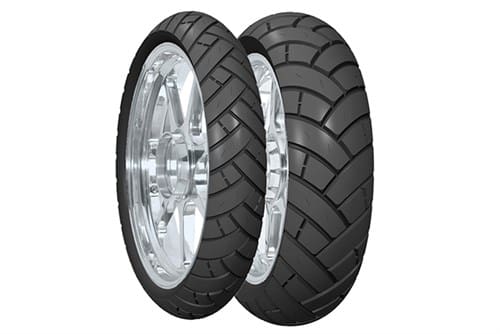TrailRider range is testimony of how important the adventure touring sector is these days and also of how high in the rankings Australia is in terms of importance within that sector.
And why not? We do, after all, have more square kilometres-per-helmet worth of back country roads than virtually anywhere in the world.
The Avon TrailRider takes over from where its Distanzia dual-sport touring range left off and adds new technology and more size choices – notably with the addition of 170/60 and 180/55 section 17-inch radials available for the wider-wheeled adventure sport bikes and soft roaders. The rest of the range consists of a comprehensive selection of sizes to cover every bike likely to require such a tyre.
Six fronts are available in 17-, 19- and 21-inch diameters, with radial options in 17 and 19 inch. There are 12 rears, all in 17- or 18-inch diameter, ranging from 110/80 up to 180/55, half of which are radials.
Avon has been developing this new tyre for two years – a task that motorcycle tyre design engineer Ashley Vowles said was far more challenging than producing something like a supersport tyre, due to the wide variation of surfaces and conditions adventure touring can encounter, from gravel tracks to the unlimited tarmac speeds of European autobahns, and often with the extra burden of carrying extreme loads.

One of Avon’s achievements with the new TrailRider is that it has managed to cram more wet-weather, grip-boosting silica into the tread compound than ever before. It’s all thanks to a lot of hard work in the chemical laboratory back at the Avon factory and development facility at Melksham, UK, where the company has been based by the River Avon for more than 100 years.
This new silica-rich compound was developed for the needs of the TrailRider, but Avon also borrowed technology from its high-performance road tyres, with three-dimensional sipes included on all TrailRider radials. Sipes are the small slits found in some tyres which have the job of allowing heat-generating movement in the tread for quick warm-up times.
Avon has pioneered the process of producing sipes with an interlocking textured finish beneath the tread. This is said to control the amount of tread movement, aiding stability and preventing the tyre from overheating and causing extra wear, and also allows the sipes to be created to the full depth of the tread pattern.
Radial rears get the added feature of a three-compound construction to give more cornering grip without compromising wear rates.
Avon describes the TrailRider as being aimed for 90 percent road and 10 percent off-road use, but I think is slightly underrating the TrailRider’s off-road capabilities, thanks largely to a fairly chunky tread pattern. Despite its chunkiness, the TrailRider rolls on the tarmac smoothly and with no audible rumble at speed. The grip level on both damp and dry roads was excellent and inspired confidence on all of the wide variety of bikes available on the test ride.
Although the off-road testing was confined to a large area of gravel carpark, this was enough to show the TrailRider possesses a high level of progression, grip and feel on loose surfaces for a tyre in this category – no doubt helped by the extra teeth provided by fairly wide tread grooves.
Understandably, there is currently a lot of activity in the dual-sport tyre market, as our recent comprehensive adventure tyre guide proved (Vol 65 No 01), but the TrailRider shows that it isn’t just the mega brands of the tyre industry which are leading the way out on the trail.











